Tokyo Paralympics: A-Z guide to history of Games
- Published

The Paralympic mascot Someity with the Agitos logo
Paralympic Games on the BBC |
|---|
Venue: Tokyo, Japan Dates: 24 August-5 September Time in Tokyo: BST +8 |
Coverage: Follow on Radio 5 Live and on the BBC Sport website |
The 16th summer Paralympic Games are set to begin with the opening ceremony in Tokyo on 24 August, with 539 gold medals to be won across 22 sports over 12 days of competition.
We've taken an alphabetical look through the history of the Games, from athletics to Zorn via classification and Kenny...
A is for athletics: The biggest sport at the Games both in terms of events (167) and athlete numbers (1,100) and along with swimming is the only sport which caters for all impairment groups. Para-athletes compete in track events from 100 metres up to 5,000m as well as high jump, long jump, shot, discus, javelin and club throw, while there are also marathon events for certain categories.
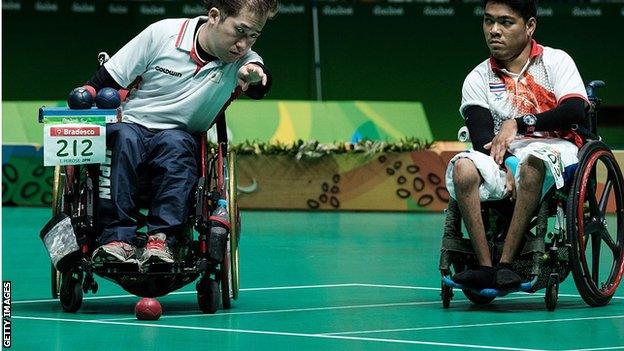
Boccia is played indoor on a court similar in size to badminton
B is for boccia: One of two sports on the Paralympic programme that does not have an Olympic counterpart - goalball is the other. Its roots are in Greece where players threw large stones at a stone target. Competitors have neurological impairments which affect their motor function, such as cerebral palsy, and are among the most impaired athletes at a Paralympics
C is for classification: The key part of the Paralympic movement. It determines how athletes are grouped together for competition and which athletes are eligible to take part in a sport. Different sports will have different classification rules. Both for Paralympic experts and newcomers to the event, it is the subject which causes the most consternation and confusion.
D is for delay: The pandemic forced the Paralympics to be postponed for 12 months and athletes across the world have had to show incredible resilience with training disrupted and competitions postponed. For many there were tough decisions about whether to carry on for another year but they will all want to put on a spectacular show in Tokyo.
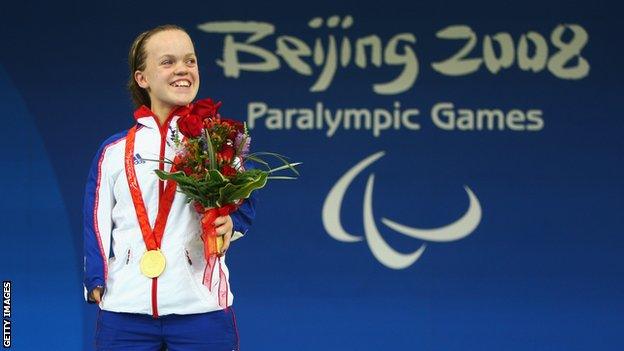
Ellie Simmonds created history with her gold medals in Beijing
E is for Ellie: Ellie Simmonds is one of the best-known faces in Paralympic sport having made her debut as a 13-year-old at Beijing 2008 where the youngest member of the GB team captured the hearts of the nation with her tears after winning her first gold medal. Now 26 and one of the veterans of the team, she will be hoping to add her eight Paralympic medals (including five golds) in what could be her final Paralympics.
F is for fencing: One of the sports which has appeared at every Paralympics, wheelchair fencing was pioneered by Sir Ludwig Guttmann, the father of the Paralympic movement and himself a keen fencer. Lightning-quick reflexes are needed across the three disciplines - sabre, foil and epee with athletes stationary rather than moving up and down the piste.
G is for Guyana: The country will be making its Paralympic debut in Tokyo with cyclist Walter Grant-Stuart carrying their hopes. The 36-year-old former firefighter lost his arm in an accident a number of years ago. G is also for gold. Each Paralympic gold medal in Tokyo weighs 556 grams and has more than 6g of gold plating on pure silver.
H is for horses: When equestrian made its Paralympic debut in Atlanta in 1996, the host nation was required to provide the horses for the competition. It was only the 2004 Games in Athens when riders competed on their own horses. Horses will travel to Tokyo on special flights and will enjoy first-class treatment.

Italian swimmers Simone Barlaam and Federico Morlacchi celebrate world success
I is for Italy: Although the Stoke Mandeville Games took place in 1948, Rome hosted the first Paralympic Games in 1960 with 400 athletes from 23 countries taking part in eight sports. Tokyo will see around 4,300 athletes representing 98 countries in 22 sports. Italy were ninth in the medal standings in Rio and could improve on that this time.
J is for Japan: Tokyo is the first city to host the Paralympic Games on two different occasions, having also staged the 1964 Games. On that occasion, the organising committee negotiated with several airlines to transport teams to the country by charter flights. A specially adapted slimmer wheelchair was also created to allow athletes to be transported comfortably down the aircraft aisles.
K is for Kenny: Mike Kenny is Britain's most successful Paralympian with 16 gold and two silver medals as a swimmer. He was left paralysed after an accident at work when he was 26 and made his debut five years later in Toronto in 1976 and his final Games was Seoul in 1988, where he won five golds and a silver. Sarah Storey is two behind his gold-medal tally and could overtake him at the Tokyo Games.
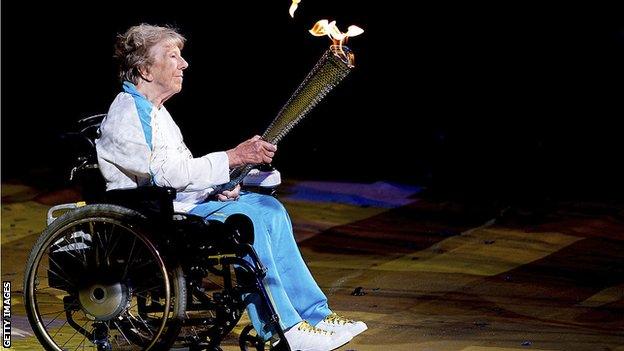
Margaret Maughan played a key role at London 2012
L is for logo: The Paralympic logo is the Agitos. It consists of three elements in red, blue and green encircling a central point and symbolises movement. The Paralympic motto is Spirit in Motion.
M is for Margaret Maughan: Maughan, who died last year, was Britain's first Paralympic gold medallist when she triumphed in an archery event at the 1960 Games in Rome. She went on to win three more golds and two more silvers in archery and swimming across four Games and lit the cauldron at the opening ceremony of the 2012 Paralympics.
N is for new: There are two new sports at this Games - Para-badminton and Para-taekwondo after Para-canoe and Para-triathlon made their debut last time around. Both were approved in January 2017 and replace sailing and seven-a-side football, which were dropped after Rio. Other sports which had been up for consideration were amputee football, powerchair football and power hockey.
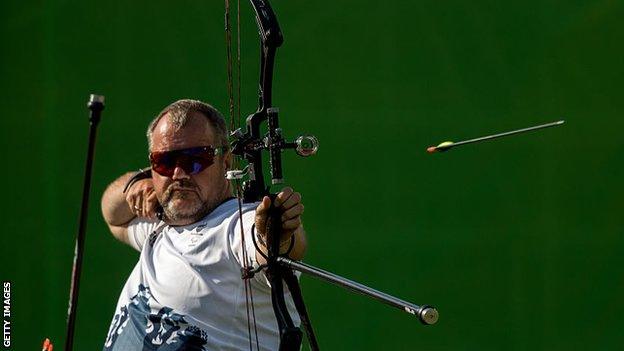
John Stubbs will be hoping to add to his Paralympic medal tally
O is for old: The oldest member of the GB team in Tokyo is archer John Stubbs. The 56-year-old won individual gold in Beijing and team silver in Rio. Swimmer Ellie Challis (17) is the youngest member of the team.
P is for Parsons: Brazil-born to English parents, Andrew Parsons is the president of the International Paralympic Committee. He has a long history in sports administration with the Brazilian Paralympic Committee and took over from Sir Philip Craven in 2017. P is also for Paris. The French capital will be hosting the next summer Games in three years' time.
Q is for quiet: For many of the visually impaired athletes, silence is key for them to be able to take part in their event. Whether it is the blind long jumper who needs verbal commands from their coach to ensure they take off at the right place, or goalballers and football players needing to be able to hear the ball, cheering is only appreciated at the right time.
R is for rifle: Along with pistol, one of the two shooting disciplines. In the 10m air rifle event, the whole target is 4.5cm in diameter and the central ring is just half a millimetre across. The sport made its Paralympic debut in Toronto in 1976 and has featured at every Games since.
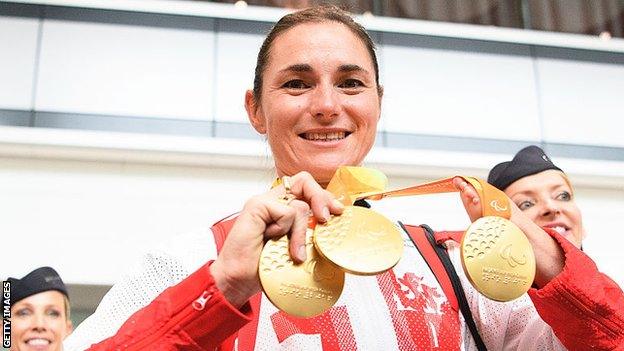
Sarah Storey won three gold medals at Rio 2016
S is for swimming and Storey: She is now a cycling star but Sarah Storey started her Paralympic career at the 1992 Barcelona Games as a swimmer, winning 15 medals, including five golds. A series of ear infections forced her out of the water but her switch to the bike has been a sporting success with nine more golds.
T is for Tanni: One of Britain's greatest athletes, Tanni Grey-Thompson dominated her wheelchair racing events across five Paralympics, winning 11 golds, four silvers and a bronze. She also won six London Marathon titles from 1992 and 2002. She retired in 2007 and was created a life peer in 2010. Now Baroness Grey-Thompson, she has spoken in the House of Lords about welfare reform, accessibility and equality, among other topics.
U is for Ukraine and the United States: The USA have always been one of the strong Paralympic nations but having slipped to sixth in the medal table at 2012, they were fourth in 2016 and the 2028 Games hosts will want to put down a marker. Ukraine have made massive strides in recent times, thanks to huge investment in summer and winter Para-sports and will also be aiming for a top-five spot.
V is for va'a: In Rio, Para-canoe was kayak racing only but in Tokyo, the va'a boat makes its debut. It is a long outrigger canoe which has a second pontoon as a support float and uses a single-blade paddle. It originated in the Pacific Ocean around 4,000 years ago where Polynesians and their ancestors used them for ocean travel but they have now developed into smaller racing boats.
W is for wheelchair: Wheelchair technology has evolved beyond all recognition and top-level competitors now have lean, mean racing machines! Competitors in wheelchair basketball and wheelchair tennis are among those to have specially designed chairs for the requirements of the sport while wheelchair rugby chairs are reinforced to deal with the impact of chair on chair.
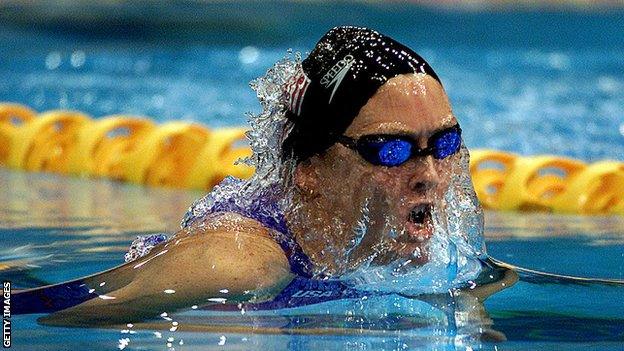
Trischa Zorn was a trailblazer for Para-sport in the USA
X is for X-rated: One of the most memorable moments of London 2012 was Para-cyclist Jody Cundy's furious rant after his rear wheel slipped when leaving the starting gate as he defended his title in the C4 1000m time trial and he was denied a restart and disqualified. Cundy went on to regain his title in Rio and goes again in Tokyo.
Y is for the Yoyogi National Stadium: The venue for the wheelchair rugby and Para-badminton competitions. It was built for the 1964 Olympics where it hosted swimming, diving and basketball and also staged handball at the recent Olympic Games. It has staged a variety of sporting events and also music concerts by, among many others, Queen, Westlife and Britney Spears.
Z is for Zorn: US swimmer Trischa Zorn is the most decorated Paralympian of all time with a total of 55 medals across seven Games - 41 golds, nine silvers and five bronzes. Zorn was born blind and started swimming aged 10. She made her debut in Arnheim in 1980 and finished her career with a bronze in Athens in 2004 aged 40.

Breaking taboos in sport: Simone Biles, Naomi Osaka, Ben Stokes and their powerful message about mental wellbeing
For The Love of Hip Hop: Romesh Ranganathan dives into the genre, not always successfully
